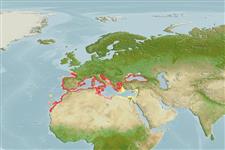Common names from other countries
Environment: milieu / climate zone / depth range / distribution range
Ecologia
marinhas demersal; intervalo de profundidade 0 - 120 m (Ref. 122887). Subtropical; 50°N - 10°N, 18°W - 42°E
Eastern Atlantic and Mediterranean Sea: including the Adriatic, Aegean and Black Sea, Portugal and Senegal. Has also been reported from southern Morocco, Mauritania, and Angola (Ref. 10813).
Tamanho / Peso / Idade
Maturity: Lm ? range ? - ? cm
Max length : 17.0 cm TL macho/indeterminado; (Ref. 3397); common length : 12.5 cm TL macho/indeterminado; (Ref. 3397)
Descrição breve
Chaves de identificação | Morfologia | Morfometria
Espinhos dorsais (total) : 0; Raios dorsais moles (total) : 53 - 59; Raios anais moles: 27 - 32; Vértebras: 64 - 68. Ventrolateral skin-folds extending well beyond pectoral fins to anus. Lateral line branched. Back golden brown or greenish, belly silvery, head usually dark blue.
Found over shell-gravel and coarse sand bottoms (Ref. 6450). Minimum depth from Ref. 122877.
Life cycle and mating behavior
Maturities | Reprodução | Spawnings | Egg(s) | Fecundities | Larvas
Quéro, J.-C., 1990. Ammodytidae. p. 920. In J. C. Quéro, J. C. Hureau, C. Karrer, A. Post and L. Saldanha (eds.) Check-list of the fishes of the eastern tropical Atlantic (CLOFETA). JNICT, Lisbon; SEI, Paris; and UNESCO, Paris. Vol. 2. (Ref. 10813)
Categoria na Lista Vermelha da IUCN (Ref. 130435)
CITES (Ref. 128078)
Not Evaluated
Ameaça para o homem
Harmless
Utilização humana
Pescarias: espécies comerciais
Ferramentas
Relatórios especiais
Descarregue XML
Fontes da internet
Estimates based on models
Preferred temperature (Ref.
115969): 7.8 - 18.1, mean 14.3 (based on 57 cells).
Phylogenetic diversity index (Ref.
82804): PD
50 = 0.6250 [Uniqueness, from 0.5 = low to 2.0 = high].
Bayesian length-weight: a=0.00102 (0.00046 - 0.00225), b=3.06 (2.88 - 3.24), in cm Total Length, based on all LWR estimates for this body shape (Ref.
93245).
Nível Trófico (Ref.
69278): 3.4 ±0.45 se; based on food items.
Resiliência (Ref.
120179): Elevada, tempo mínimo de duplicação da população menor que 15 meses (Preliminary K or Fecundity.).
Fishing Vulnerability (Ref.
59153): Low vulnerability (10 of 100).
